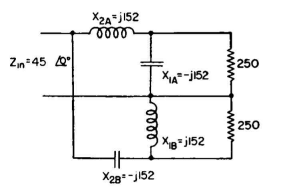| Radio Antenna Engineering is a free introductory textbook on radio antennas and their applications. See the editorial for more information.... |

|

Home  Impedance-matching Networks Impedance-matching Networks  Calculation of Circuit Losses Calculation of Circuit Losses |
||||






|
||||
|
Calculation of Circuit LossesAuthor: Edmund A. Laport
In solving for the reactance required in a network of given performance, the choice of potential and current values at the beginning of the problem is immaterial and determined by convenience only. For definite design applications, however, it may be best to work the problem with potential and current values corresponding to the power expected in reality.
|
||||
Home  Impedance-matching Networks Impedance-matching Networks  Calculation of Circuit Losses Calculation of Circuit Losses |
||||
Last Update: 2011-03-19


